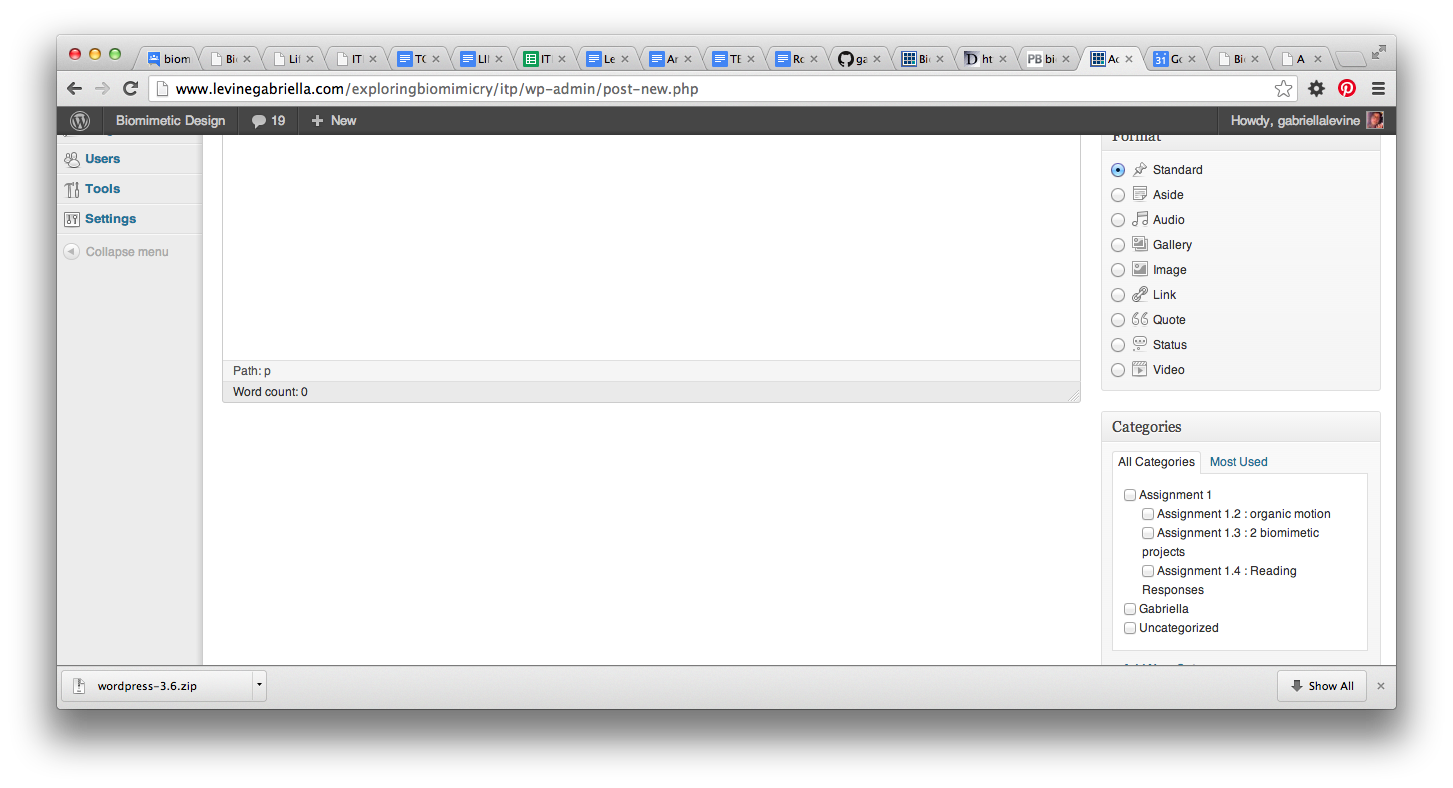Assignment 5. [Due Tuesday 10/22/2013]
1. Bring in a functioning prototype. Between class 6-7 , the work should be mainly finishing touches. For example, you should have multiple joints connected together that move on their own or based on user input).
2. Begin your Project Presentation. Next week you will go through the entire presentation, and then demonstrate your progress on the robo-arm. Feel free to use this template in keynote (here is a ppt version, and here is just a pdf version)
Assignment 4. [Due Tuesday 10/8/2013]
Build out the prototype
Assignment 3. [Due Tuesday 9/24/2013]
more info can be found on here: ASSIGNMENT_3_
THE DESIGN CHALLENGE: Redesign a system from a biological perspective
ASSIGNMENT FOR WEEK 4:
1. Generate a Point of View statement (follow the guidelines below)
2. After doing some user research, design 1 Wireframe of three possible concepts for the system you will build.
This documents who the user is, what is the POV statement, what is the interaction of the user with three separate systems that address the need of the user
(ie three systems might include an app, a robot, and a new type of metrocard. Next week we will decide on the system we will build)
3. 1 Visual Diagram : What biological system are we drawing inspiration from for your system? Demonstrate why does this optimize the system/design.
4. Technical : What materials might we think about for the final project? Make a list or a schematic.
THE DESIGN CHALLENGE
Redesign a system, a concept, or a solution that is improved by looking to a particular biologicalfeedback system as a reference. The starting point will be a user, and the user can be human or non-human.
Your built system should enhance the user in some way. It might improve their methods of communication or information exchange with others. It might augment sensory or physical capabilities.
Possible platforms and mediums:
A concept, device, user interface, an Architectural replica, a web application
Assignment 2. [Due Tuesday 9/17/2013]
Design a new kind of biomimetic sensor:
Identify a living organism, or the sensory system of a particular organism. Design a concept for a new type of sensor that mimics that organic system. [You can use organic material]
Present at a concept diagram that explains:
1. who is the user?
2. what is the task accomplished?
3. Why is it unique?
4. Outline the technological / fabrication methods that you would use to accomplish this.
Assignment 1. [Due Tuesday 9/10/2013]
All of the assignments must be documented here, online. You should either post to this site or link from here to your OWN SITE. For each post, check two categories for each post: YOUR NAME & the ASSIGNMENT.
Follow this link for instructions to log in and post.
[If you are blogging on your OWN SITE, a link to the documentation is fine, rather than the entire content on this site, but you must at least post a link to your work.]
For each blog post, check: 1. your name 2. the assignment. For this first assignment, you should write [or link to] three posts [see assignment 1.2, 1.3, 1.4]

FOR NEXT WEEK:
1. Join the Biomimetic Design ITP Google Group
2. Build & Prototype: Output: organic motion
Design a physical system based on a particular organisms motion. This can be as specific as perhaps designing a robotic elbow. Keep it simple. This does not need to be based on an animal joint, for example consider the venus fly trap. But it has to move. You can also use the robotic arm.
By next class, you must bring in your piece to show. You must also blog about your work and process, with photos and writing.
This can be a joint that moves back and forth. This can be a rotational motion or linear motion. This can incorporate electronics and even a visual screen-based component. This has to move, and can move on its own or with some type of human input (ie a button press). Consider various actuation methods : will your system use motors to move? air power to move?
The following must be clear:
1. What biological system or joint is your device based on?
2. What type of motion is it? [is it back and forth? does it rotate continuously?]
2. What is the purpose of the system? is it to carry something? is it to dance? is it to move?
2. Document Biomimetic designs:
1. An example of an inspiring biomimetic project you love
2. An example of a biomimetic project you hate
Document with photos and writing on this site: what is the project, who created it, why do you / dont you like it?
3. Readings [links & more info on the class website]
1. http://biomimicry.net/about/biomimicry/
2. Bar-Cohen: Biomimetics—using nature to inspire human innovation
3. Designing features for Fido WHAT MAKES ANIMAL-COMPUTER INTERACTION SO DIFFERENT FROM HUMAN-COMPUTER INTERACTION?
Write a 1 paragraph response to each. Consider the following questions for each reading:
1. Is this a complete definition of what you think of as biomimicry? Does this definition define nature in an appropriate way? What might be lacking in Janine Benyus’ definition of “life’s principles”?
2. Is the metaphor of biology to engineering systems pertinent and relevant, as Bar-Cohen compares them? Can you consider further advantages to biomimetic design than the properties of biomimetic principles that Bar-Cohen defines?
3. What are the implications for designing for animal-interaction? What is the differences / similarities between designing for non-human users rather than designing inspired by non-human organisms? Where does “living design” fit in all of this?